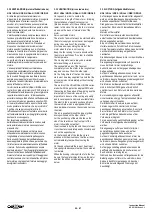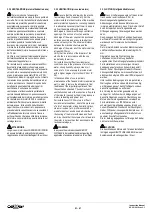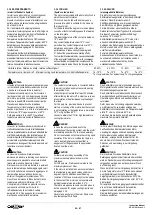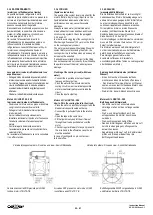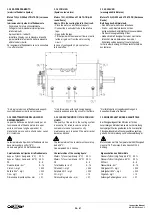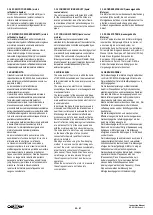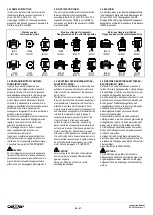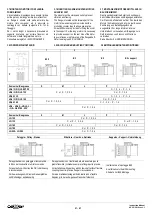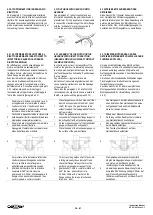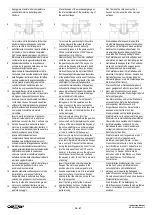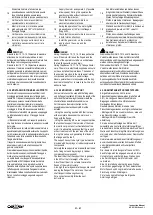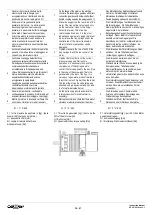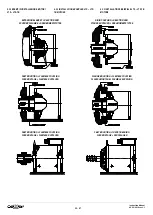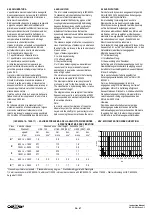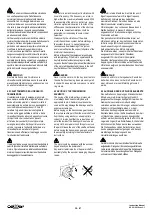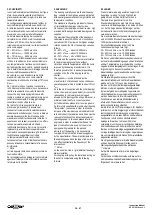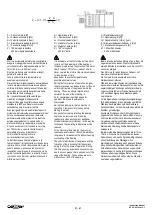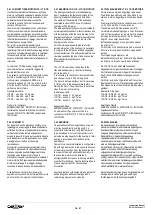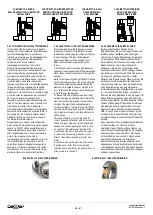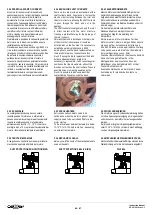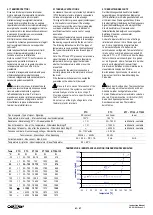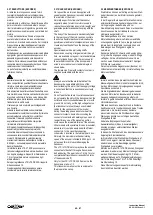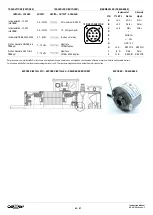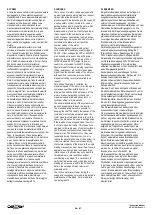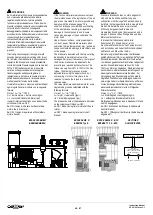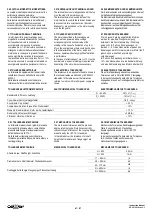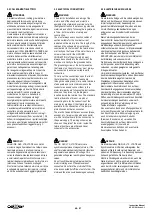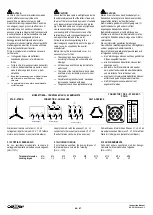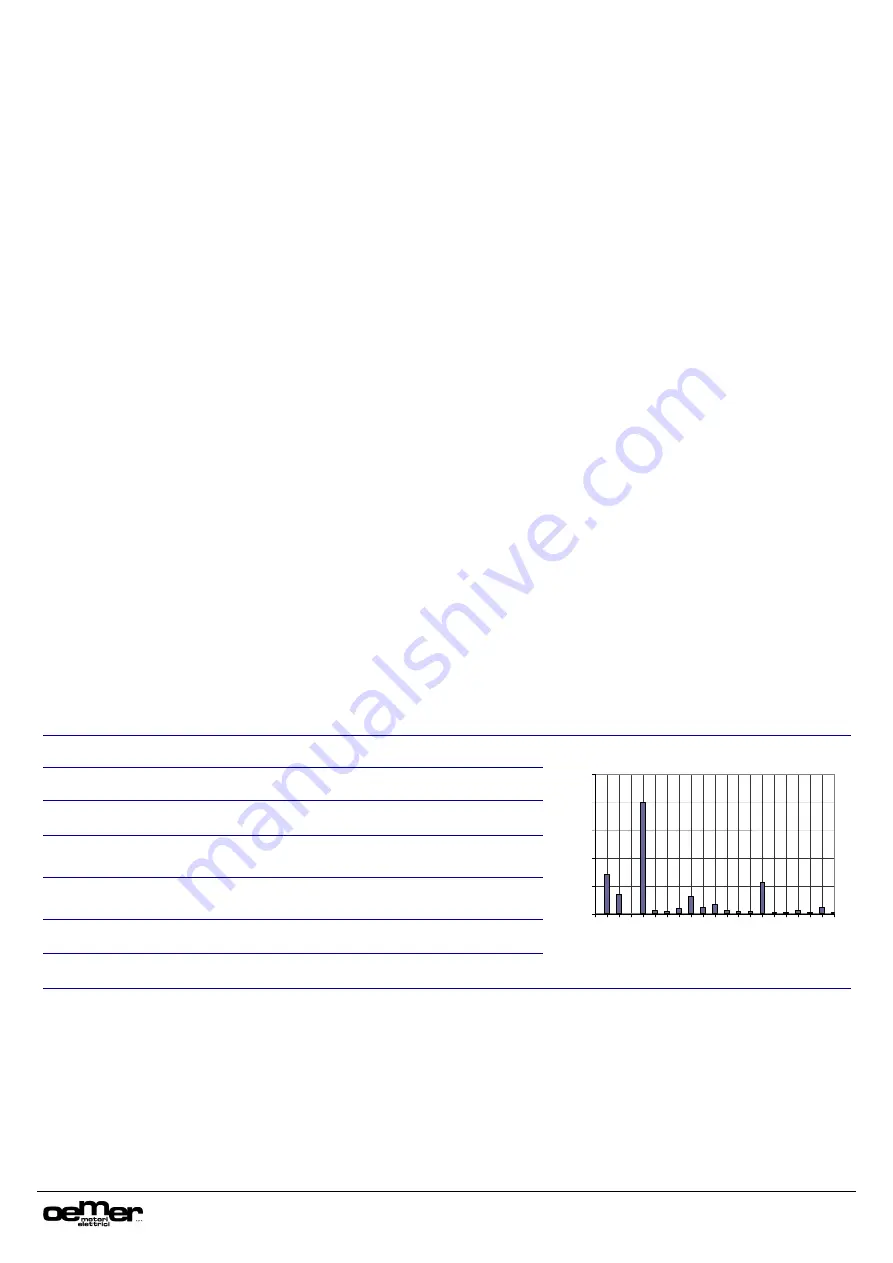
34 - 97
Instruction Manual
AC 02/2019-rev.1.1
4.4 EQUILIBRATURA
L’equilibratura meccanica del rot
ore è eseguita
dinamicamente secondo la norma IEC 60034-14
che stabilisce il comportamento di vibrazione
delle macchine elettriche.
È indispensabile che anche la puleggia, semigiunto
o pignone, vengano bilanciati dinamicamente
prima di essere calettati sull’albero di trasmissione.
Eventuali vibrazioni durante il funzionamento del
motore sono indice di squilibrio dell’organo di
trasmissione che deve essere bilanciato per non
compromettere la durata dei cuscinetti, degli
accessori e la vita della macchina.
Il grado di vibrazione standard corrisponde alla
classe N ed il tipo di equilibratura è indicato
sull’albero del motore e sulle schede tecniche.
Tipi di equilibratura disponibili:
F = equilibratura con chiavetta intera.
H = equilibratura con mezza chiavetta.
N = equilibratura senza chiavetta.
A richiesta, per applicazioni speciali e per
garantire ridotte vibrazioni anche ad elevata
velocità è possibile richiedere l’equilibratura di
grado R o S.
I valori di vibrazione indicati nella tabella
sottostante sono riferiti alle norme IEC 60034-14.
Il livello di vibrazione massima è espresso in
mm/s ed è valido per metodo di rilevamento a
sospensione libera. La suddivisione avviene per
classe di equilibratura, velocità di rotazione ed
altezza d’asse motore.
Il grafico sotto riportato è un esempio delle varie
frequenze di vibrazione presenti in un motore in
rotazione a 3600 rpm.
Note:
Per ottenere vibrazioni contenute di tutto il
sistema cinematico è fondamentale che l’o
rgano
meccanico calettato sull’albero del motore
(giunto, ingranaggio, puleggia) venga equilibrato
con il metodo corrispondente a quello del motore.
4.4 BALANCING
The rotor is balanced dynamically to IEC 60034-
14 standards, which establishes the vibratory
behaviour of electrical machinery.
It is also essential that the pulley, pignon or half
coupling, are balanced dynamically before being
keyed on the transmission shaft. Any vibrations
during operation of the motor are indicative of
imbalance of the transmission that must be
dynamically balanced to avoid lifetime reduction and
damage of the bearings, the accessories and the
machine.
The standard degree of vibration corresponds to
class N and the type of balancing is indicated on
the shaft of the motor and in the technical sheets
of each series.
Types of balancing available:
F = whole key balancing.
H = half key balancing.
N = keyless balancing.
R or S class balancing degree is available on
request and it is recommended for special
applications, to guarantee reduced vibrations
even at high speed.
The vibration values indicated in the following
table refer to standard IEC 60034-14.
The maximum vibration level is expressed in
mm/s and is valid for the free-hanging method.
The classification is by balancing class, rotation
speed and shaft height.
The diagram shows an example of the vibration
frequencies present in a motor rotating at 3600
rpm, suspended and mechanically insulated from
the machine structure.
Note:
In order to reduce the vibrations of the entire
kinematic system, the mechanical members
keyed onto the shaft (joint, gear, pulley) must be
balanced using the same method as the motor.
4.4 AUSWUCHTUNG
Der Läufer wird dynamisch ausgewuchtet, gemäß
Norm IEC 60034-14 bezüglich des Schwingungs-
verhaltens elektrischer Geräte.
Es ist unbedingt notwendig, dass auch die
Riemenschiebe, die Kupplung und aufgebaute
Ritzel dynamisch ausgewuchtet werden, bevor sie
auf die Antriebswelle aufgezogen werden.
Vibrationen während dem Betrieb des Motors sind
ein Zeichen nicht ausgeglichener Übertragungs-
elemente, die ausgewuchtet werden müssen, um
die Lebensdauer von Lagern, Zubehör und der
Maschine selbst nicht zu reduzieren.
Der Standard Schwinggüte entspricht Klasse N. Die
Auswuchtart ist auf der Antriebswelle und in den
Datenblättern jeder Baureihe angegeben.
Mögliche Auswuchtarten:
F = Vollkeilwuchtung.
H = Halbkeilwuchtung.
N = Auswuchtung ohne Passfeder.
Auf Anfrage sind für Sonderanwendungen und zur
Gewährleistung verminderter Schwingungen auch
bei erhöhter Geschwindigkeit die Auswuchtklassen
R bzw. S verfügbar.
Die in nachstehender Tabelle angeführten
Schwingungswerte beziehen sich auf Norm IEC
60034-14.
Der max. Schwingungspegel ist in mm/s
angegeben und gilt für die Messung bei frei auf
gehängtem Motor. Die Aufteilung erfolgt nach
Auswuchtklassen, Drehzahl u. Antriebswellenhöhe.
Die nebenstehende Grafik ist ein Beispiel für die
verschiedenen Schwingungsfrequenzen eines
Motors bei 3600 U/min.
Hinweise:
Damit das kinematische System nur geringe
Schwingungen aufweist, müssen die auf die
Antriebswelle gepressten mechanischen Elemente
(Kupplung, Zahnrad, Scheibe) mit dem gleichen
Verfahren wie der Motor ausgewuchtet werden.
(IEC 60034-14
–
1998-11) - VALORE EFFICACEMAX. DELLA VELOCITÀ DI VIBRAZIONE -
MAX. EFFICIENT RATING SPEED VIBRATION-
EFFEKTIVWERT MAX. DER VIBRATION
Class
Velocità
–
Speed
Altezza d’asse
-
Shaft height
- Achshöhe [mm]
0
0,1
0,2
0,3
0,4
0,5
0
23
60
121 188 206 227 242 473 721 952
Hz
mm/s
Klasse
Drehzahl
H 56…132
H 160…225 (280)
1)
H 225 (280)
1)
…400
speed
Vel.
Acc.
Vel.
Acc.
Vel.
Acc.
Rpm
mm/s
m/s
2
mm/s
m/s
2
mm/s
m/s
2
N *
600 < n
3600
1.8
-
2.8
-
4.4
-
R
600 < n
1800
1800 < n
3600
0.71
1.12
-
1.12
1.8
-
1.8
2.8
-
S
600 < n
1800
1800 < n
3600
0.45
0.71
-
0.70
1.12
-
1.1
1.7
-
A
1)
600 < n
3600
1.6
2.5
2.2
3.5
2.8
4.4
B
1)
600 < n
3600
0.7
1.1
1.1
1.7
1.8
2.8
*Classe di equilibratura standard - *
Standard balancing degree
- * Standardmäßig geliefertE Wuchtgüte.
1) Valori secondo norma IEC 60034-14, edizione 11/2005
–
Values in accordance with IEC 60034-14 , edition 11/2005
–
Werte in Einklang mit IEC 60034-14,
Ausgabe 11/2005

